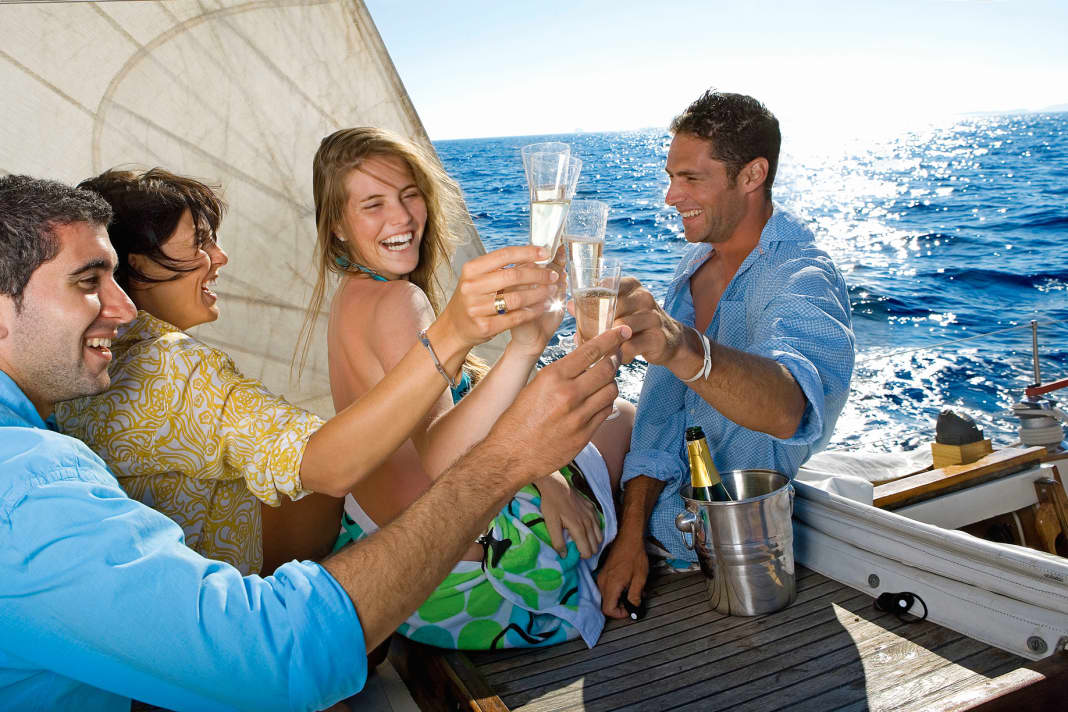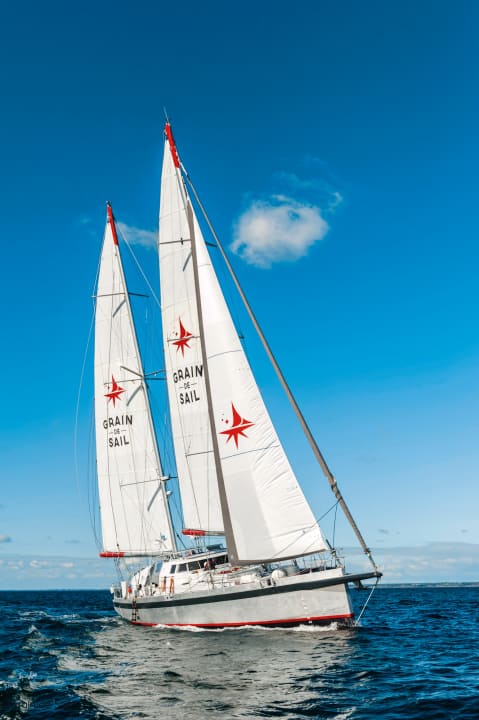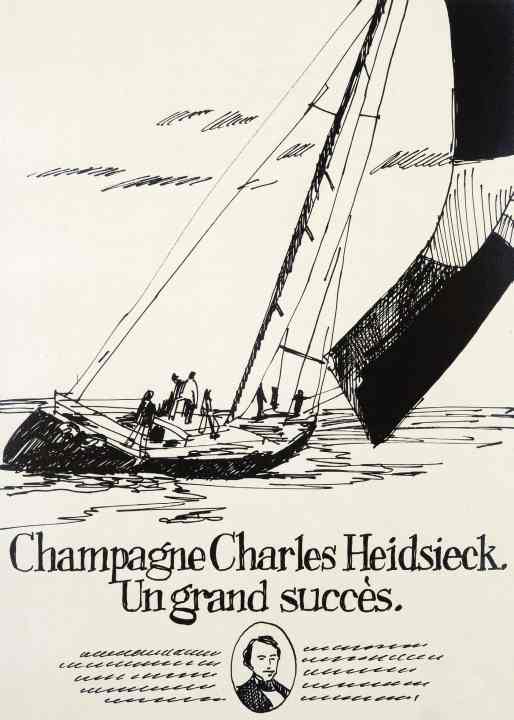





Champagne sailing. Hardly any other neologism is able to enchant sailors more. This one word alone manages to make us forget all the cold days and clammy fingers, and instead brings sailing in its condensed beauty to our minds' eye.
Champagne sailing. We can literally see all the stimuli that sailing is all about. The sails that stand in the wind with a slight shift. The boat pulling light as a feather across the sea. Blue sky, white clouds. We can see the hull as it glides smoothly through the waves and floats its foam track into the sea - acoustically tantalising, visually unbeatable. We sit at the tiller, lean against the steering wheel and listen to the gentle foaming that surrounds us as the boat pulls along at four or five knots. A fine bubbling that ripples along the waterline. The water is thrown up into a mousse-like carpet that whirls along in the form of millions of tiny bubbles, only to evaporate again seconds later into the colours of the sea.
Why do they say champagne sailing?
Intoxicating. Yes, that's exactly what it's like when everything is just right while sailing. When wind, water, sailing ship and human heart come together to create moments of unheard-of happiness. And there is only one word that can describe this tantalising state. That is: champagne sailing. But where does this term actually come from? Who invented it? Does the word really have its roots in the onomatopoeic description that equates sailing with the enjoyment of fine sparkling wine? Does the term really refer to that slightly fizzing rim of bubbles in the glass? To that fine perlage when the carbon dioxide dissolved in the champagne escapes as soon as we uncork the bottle? Or was the creator of this extremely pretty word perhaps thinking more of the intoxicating effect that sets in both when we are sailing perfectly and when we have had a few glasses?
We will probably never be able to get to the bottom of this question. The word Champa- gnersegeln is not listed in any dictionary, Oxford Dictionary or etymological dictionary. Rather, the word is a piece of sailing slang. A sophisticated special term that is only understood by those who know about the beauty of sailing. It is almost impossible to get to the source of the language with such sophisticated sailor's vocabulary. And so we will probably never know where the word originated and how it possibly came into the world.
Champagne is sprayed after big victories
The images of the America's Cup and other major regattas are well-known, when the winners are handed the champagne bottles after the race and pop the corks. Such scenes are familiar from Formula 1, various Grand Prix events and sailing. But this is more likely to be about an opulently arranged victory team, not about the inherent qualities of the sport that are being expressed. No, athletes splashing about with fine cuvée have little to do with the heart of the matter.
Another causal link between champagne and sailing can be found today in the form of upscale sunset cruises. The noble drink is served on board a yacht while the guests are sailed towards the sunset under flapping sails. A kitschy and clichéd affair that can now be booked on various boats between Palma and Tahiti in the spheres of sophisticated holiday experiences. For example in Florida, where this highly unseamanic ritual is advertised as follows: "Escape the daily grind in the calm waters off Key West on this sunset champagne boat tour for adults. Enjoy the serenity of late afternoon sailing on a comfortable catamaran limited to 14 passengers."
No, that's definitely not where the word champagne sailing comes from. And certainly not its profound connotations, which have about as much in common with blissfully gliding honeymooners on the pulpit as a ship's hull has with a concrete block.
Champagne and sailing- A wondrous liaison
Champagne and sailing? Well, it is a truly wondrous liaison that we are dealing with here. Especially as proper sailors generally prefer a rum to sipping a low-proof sparkling wine anyway. Far too sophisticated. Far too weak. Far too expensive.
All the more striking in the recent history of sailing are some yachts that were not only doused with champagne in the joy of victory and that were not only labelled with a sponsor's logo in the sign of the sparkling wine - but which themselves bore the name of such a noble drink. This refers to those famous sailing ships whose hulls bore the letters "Charles Heidsieck": the insignia of one of the oldest champagne brands in the world.
It all began in 1979, when the "Charles Heidsieck I" was launched in France. In the 1980s, several yachts bore the name "Charles Heidsieck" and competed in famous regattas. In 1980, for example, the "Charles Heidsieck II" took part in the Transat en Solitaire from Plymouth to Newport, skippered by Jean-Claude Parisis. In 1981/82, French sailing star Alain Gabbay sailed the "Charles Heidsieck III" around the globe in the Whitbread Race, a monohull yacht over 20 metres long, which was considered the most innovative ship in the race and achieved remarkable average speeds even back then.
During a stopover in Mar del Plata, Argentina, the bearded skipper Gabbay can be seen with tousled hair and in full sailing gear, holding a fag between his fingers and a magnum bottle of Heidsieck champagne in his hands, which is presented to him by Rear Admiral Charles Williams after a successful Atlantic crossing. In the end, the "Charles Heidsieck III" came second in the Whitbread Race. In the same year, the yacht is renamed "Champagne Charles" and takes part in the Route du Rhum.
The "Charles Heidsieck IV", once the largest trimaran in the world
In 1984, the "Charles Heidsieck IV" was finally launched in France, the largest trimaran in the world at the time. A huge maxi-foiler that was as wide as it was long. The idea of making a sailing boat "fly" on foils had already been conceived at the time - sailing heroes such as Éric Tabarly and Paul Ricard tested the first prototypes. During these years, shipyards switched from steel and aluminium to light and stiff composite materials, while yacht designers began to model hulls, rudders and underwater hulls using computer programs.

The yachts were getting bigger and more specialised, such as the "Charles Heidsieck IV" designed by Gilles Vaton, which was way ahead of its time. Initially, the ship was to sail from Lorient across the Atlantic to Bermuda in the Transat en Double regatta, but then skipper Alain Gabbay took on the yacht and wanted to teach it to "fly".
The ship was nothing more than a machine under sail: 26 metres long, 26 metres wide, 31 metres mast height, almost 800 square metres of sail area, constructed using carbon sandwich construction. But the boat - equipped with foils, wing mast and inflatable sails - was still too heavy. When sailing, it reacted like a wild horse.
When the trimaran set off on the Route de la Découverte in the Bay of Biscay in 1985, the mast broke and the centre hull was damaged. The boat was brought back to Brest, and it was to cost millions more to get the sailing monster back into shape. In September 1985, Alain Gabbay and the famous champagne brand Heidsieck stopped the campaign - because the costs exceeded all budgets. The huge boat is put up for sale. Without success. Nor did it find a new owner at auction. It lies unnoticed in a harbour in France for a while and is plundered. Then a new owner buys it, transfers the trimaran to the Mediterranean and converts it for charter trips. Years later, in 2004, the ship was hit by a hurricane in the Caribbean and was almost completely destroyed. The infamous trimaran did not reappear until 2018: The mother of all offshore trailers lies abandoned and decapitated in an arm of a river in the Dominican Republic.
The "Grain de Sail" revitalises the Heidsieck myth
A lot of wind about champagne, you might think. However, it was primarily the "Heidsieck" brand that appeared - and continues to appear - in the name of sailing. Recently, however, it is neither regattas nor spectacular circumnavigations of the globe that Heidsieck has been focussing on. Instead, last summer, the sailing ship "Grain de Sail" left the harbour of Saint-Malo to head for New York from Brittany - on board a cargo of the latest editions of an anniversary cuvée for the American market. And this ship also has a special story to tell. The "Grain de Sail" is a one hundred per cent cargo ship: certified to transport goods, but travelling emission-free, powered only by the wind.

The idea for the "Grain de Sail" was born in 2010. Two Breton twins and experts in renewable energy wanted to transport goods across the Atlantic in the most sustainable and resource-efficient way possible in times of climate change. The ship was to transport wine from France to New York on its way from Europe to the USA and cocoa and chocolate from Colombia and Brazil to Europe on the return journey. All under sail.
After almost four years of development, the "Grain de Sail" was finally created: a 24-metre-long aluminium schooner that crosses the Atlantic up to six times a year, carrying 50 tonnes of cargo each time. The idea of transporting goods with an alternative cargo ship and sailing goods back and forth between America and Europe was well received - and in June 2022, the schooner also brought Heidsieck champagne to the USA for the first time.
Charles Heidsieck exported more than 300,000 bottles of champagne to the USA on sailing ships
And so we are finally approaching the ancient story that probably does the word champagne sailing the most justice. A historic journey that hardly anyone knows about today, but which has gone down in the annals of the sport: about sailing and champagne. Because 17 June 2022 - the day on which the "Grain de Sail" arrived in New York with the French bottles of sparkling wine - marks the long-overdue birthday of the man who literally invented champagne sailing and is probably more closely associated with this term than any skipper after him.
Charles Heidsieck brought champagne to America
Charles Heidsieck, born in 1822, was the founder of one of the most famous European champagne houses, as well as a free spirit and businessman who was already drawn to faraway places: sailing across the Atlantic to the United States of America.
In 1851, at the age of 29, Heidsieck had already created a champagne according to his own ideas. But the French market, where the family brand was already established, did not seem enough to him. The young Heidsieck wanted to conquer the New World - and distribute his champagne in the United States of America. Quite a bold plan.

For one thing, back then Americans almost exclusively drank beer and whisky when it came to alcohol - champagne, on the other hand, was virtually unknown on the other side of the pond. Secondly, there were 6,000 kilometres of salt water between France and New York. But the jack-of-all-trades Heidsieck was not deterred by foreign drinking habits or the Atlantic.
"Champagne Charlie" became a legend
Not much is known about his first voyage. But Heidsieck bought himself a sailing ship, had it loaded with his bottles of champagne - and set sail himself and quite brazenly. He had 4,000 nautical miles ahead of him, the cargo holds crammed full of the fine wine. In 1852, he sailed on to the east coast via Halifax, heading for New York. If anyone deserves the title of champagne sailor, it is without question this young Monsieur Heidsieck.
And he not only successfully sailed his bubbly across the Atlantic, but also managed to popularise the European luxury drink in America - and soon sold it well.
Heidsieck undertook four long and adventurous voyages over the next ten years, selling over 300,000 bottles of champagne on American soil by 1857. Heidsieck became a favourite guest at high society receptions, and he and his champagne became a household name in the USA. High society in particular soon favoured passing him and his drink around: "Champagne Charlie" and his fine-tasting sparkling wine became a figurehead. And certainly for another reason. Because this gentleman didn't just arrive with full bottles. He came across the sea, under full sail.

